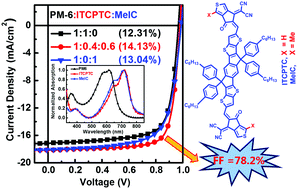Use of two structurally similar small molecular acceptors enabling ternary organic solar cells with high efficiencies and fill factors†
Abstract
Ternary blends have shown great potential to increase the power conversion efficiency (PCE) of organic solar cells (OSCs). In this work, we studied a ternary OSC system with a donor polymer (PM6) and two structurally similar non-fullerene acceptors (named ITCPTC and MeIC). Although these two small molecular acceptors (SMAs) exhibit similar absorption spectra, they introduce a surprising synergistic effect on tuning the domain size and crystallinity of the OSC blend. More specifically, MeIC is a SMA with strong crystallinity, which results in excessive phase segregation and large domain size for the PM6:MeIC binary blend. By adding a structurally similar and less crystalline SMA (ITCPTC) into the binary blend, the domain size and morphology of the blend are much improved without sacrificing the electron mobility of the blend. As a result, the optimal blend ratio of PM6 : ITCPTC : MeIC (1 : 0.4 : 0.6) led to an impressive FF of 78.2% and PCE of 14.13%, which are the highest values reported for ternary non-fullerene OSCs reported to date.



 Please wait while we load your content...
Please wait while we load your content...